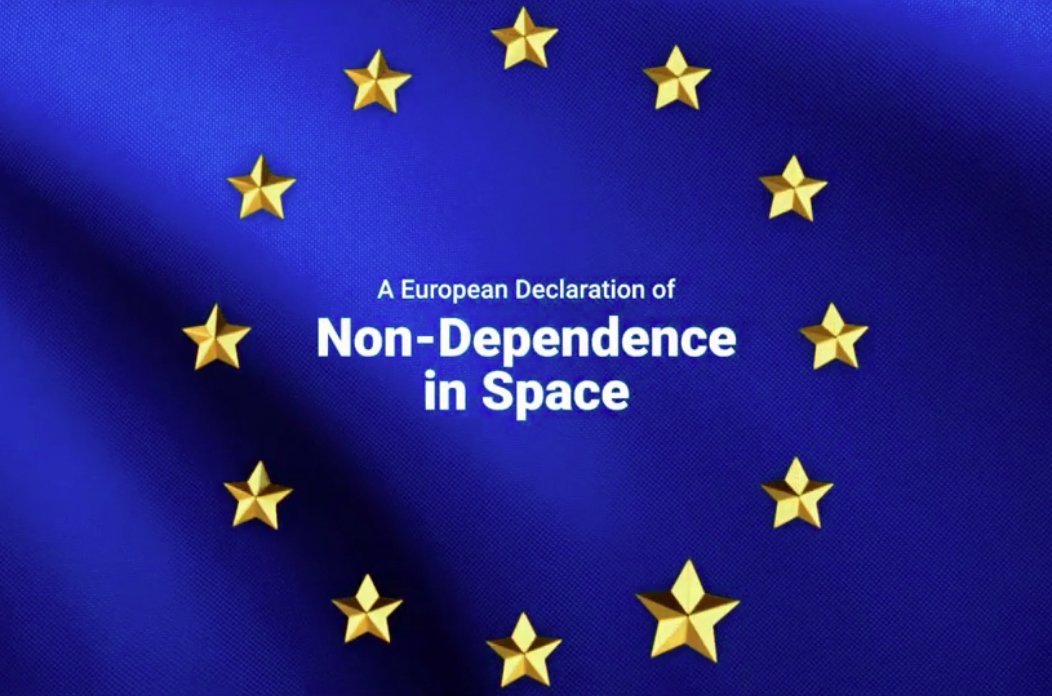January 2023
Largest joint innovation project in European spaceflight: CEOs of TAS-I, HPS and LSS kick off
Largest joint innovation project in European spaceflight: CEOs of TAS-I, HPS and LSS kick off Phase C/D of the large deployable antenna “LDRS” in the CIMR project
Since the spectacular win of the €110 million contract in 2020 for the development and construction of an LDRS (Large Deployable ReflectorSubsystem) by the SME consortium led by HPS, the project supporting to secure a sovereign European level of innovation has been running like on rails despite all its complexity. The confidence of the end customer ESA and its prime contractor TAS-I for the mission, which has grown steadily over the course of the project’s development, has now found expression on 23.01.2023 in the sealing of the departure into Phase CD by the signing of the so-called “RIDER” for the construction and testing of a qualification model (EQM) in 2023/2024, followed by no less than two flight models (PFM and FM2).
The supporting technology pillars of the innovation project are, in addition to the main innovation partners LSS (development, construction and test of the large deployable reflector), the HPS subsidiary HPtex (mesh production for the reflector), FHP (CFRP struts for the reflector), INVENT (CFRP tube for the deployable arm) and vH&S (for the deployment control electronics), further 10 companies from seven European countries under the consortium leadership of HPS.
The Environmental Observation Mission under the Copernicus Earth Observation Program of the European Union is an essential element of the European Space Strategy as a highly ambitious project in the field of climate observation and the understanding of effects of climate change.
Photo (TAS-I): contract sealing – center: Massimo Camparini (CEO of the space company ThalesAleniaSpace Italy) and the CEOs of HPS, Ernst K. Pfeiffer (right) and of LSS, Leri Datashvili.
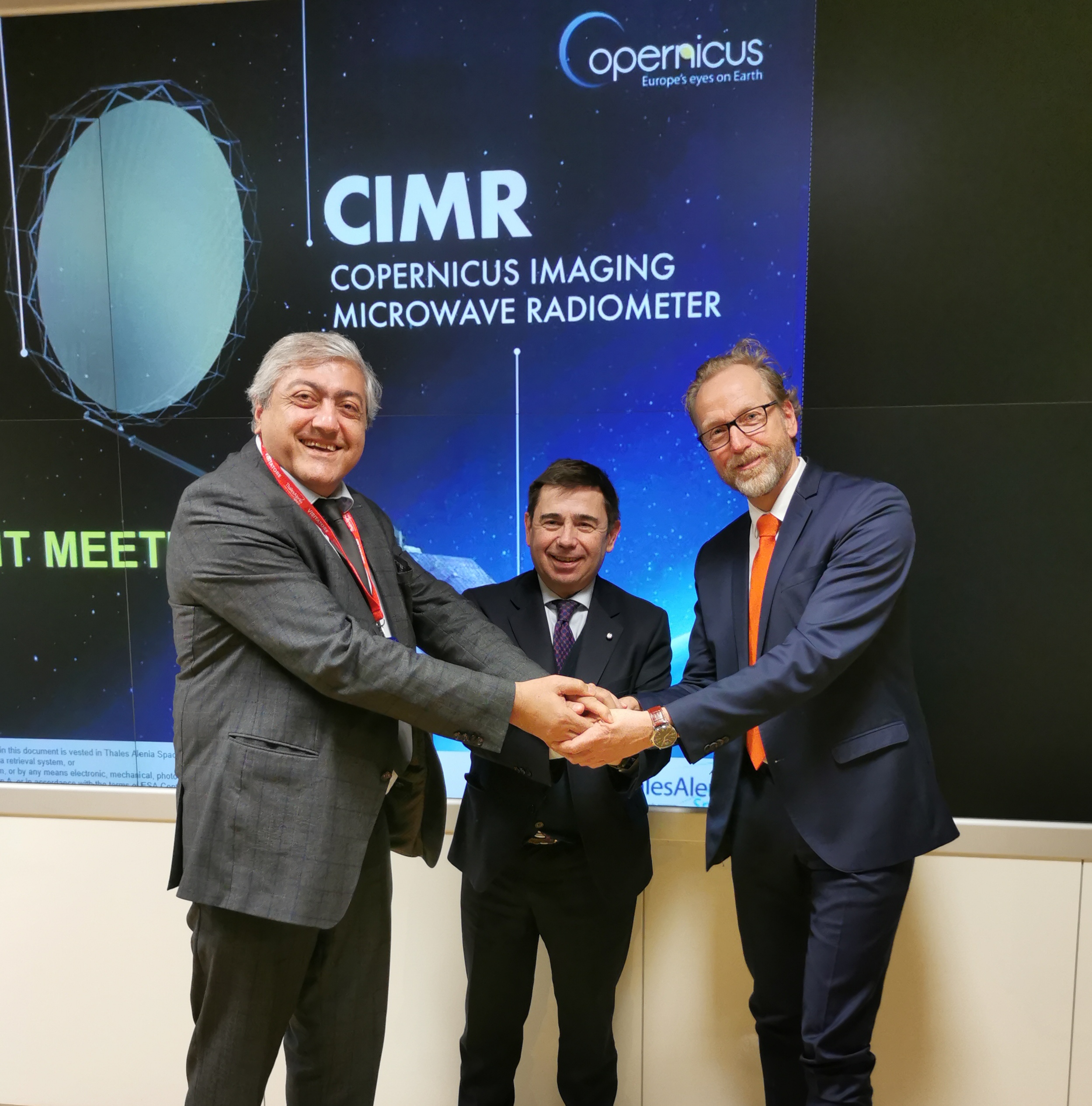
LEA-X5: New Movie on the completion of the European 5m X-band LDRS
Juli 2021
Gladly we announce with a new 20-minutes-movie the completion of the H2020-development „LEA-X5“, the 5m class European Large Deployable Reflector Subsystem (LDRS) operating in X-band.
The film itself is of course showing recent environmental and deployment tests, but it is mainly about PEOPLE, who are space engineers and space enthusiasts, and what they can achieve with combined powers and brains. These people, together with the enablers European Commission and European Space Agency, are making the achievement of „European Non-dependance“ happen.
LEA-X5 is a full LDRS-Subsystem (lead by HPS, Germany) and comprises the
- 5m diameter X-band reflector assembly (lead by LSS, Germany)
- the 5m long deployable arm assembly (lead by HPS, Germany),
- hinges & HDRMs (RUAG, DE),
- deployment electronics (vH&S, DE),
- thermal hardware (HPS/FHP).
Further partners of the H2020-consortium have been: INVENT (DE), FHP (PT), INEGI (PT), TICRA (DK), LUMA (SW), HPTEX (DE), ARQUIMEA(SP), HPS (RO), ETAMAX (DE), WSS (DE), ONERA (FR), TAS (FR), OHB (DE), Airbus (DE).
Most of the consortium members are introduced in the movie, inluding many interviews.
Take your time and enjoy the spirit of doing big things: LEA-X5 – European 5m X-band LDRS Completed (Final Report 06/2021) – YouTube
Best regards,
Your WeLEA-Consortium
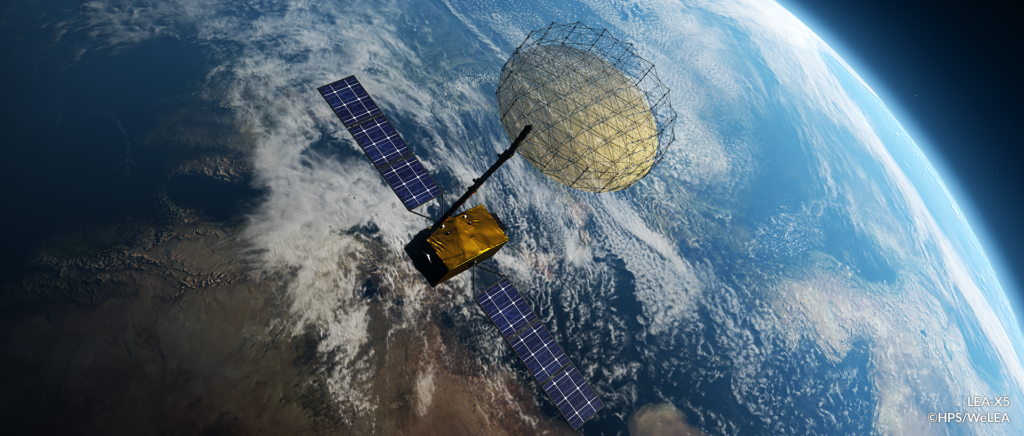
March 2021
Europe´s innovative deployable antenna technology takes the next hurdle
With the successful test of the Deployable Assembly Arm (DAA), which connects a Deployable Reflector Assembly (DRA) to the satellite, just completed at INEGI, the European LEA consortium led by HPS has cleared the next hurdle in the technical realization of Europe’s new antenna technology.
The 5m long DAA consists of 3 hinge mechanisms and 2 HDRMs (both by RUAG Space Germany), Release Mechanisms (by Arquimea, Spain), three CFRP tube segments (by INVENT, Germany), Metal Fittings (partly by HPS Romania), Deployment Control Electronics & EGSE (by von Hoerner & Sulger). Focus of the tests have been the verification of a) the functional full deployment (which takes in total 25 min.), b) a high pointing accuracy of the arm and c) the verification of the mathematical thermo-elastic models.
INEGI (Portugal) is the main partner for the arm deployment test and a good partner of HPS for over 13 years now. INEGI was responsible for the 0-g-simulation Test Stand and the Thermo-elastic Distortion Test Stand. Despite the pandemic and all restrictions the teams could manage this progress with highest motivation and closest possible contact between the INEGI/HPS team on-site in Porto and the HPS-engineers in Germany. HPS is responsible for the DAA and also for the implementation management of the whole LEA-activity. The total LEA-team encompasses 15 partners from 7 countries; the program started in the framework of H2020 in November 2017. The arm deployment test and the TED-test (thermo-elastic distortion) was one of the last tests of this H2020 activity.
The next step – starting still in March – is the environmental test (vibration and thermal vacuum) of the full LDR-Subsystem (Reflector, Arm and HDRM, all connected), which will be performed at INTA in Madrid, Spain.
“LEA-X5” (5m reflector diameter, 5m arm length, X-band application for Earth Observation and Telecommunications) is meanwhile seen as one of the precursing technology developments for the current Copernicus CIMR Mission.

March 2021
Arm and Reflector of LEA-X5 Successfully Mated to Form Complete Subsystem
Fifteen companies – mostly SMEs – from seven countries and one goal: a deployable 5-meter X-band-antenna as a preliminary development for the CIMR project, developed under the European H2020 program (2017-2021). For the first time ever, such a complete subsystem (HPS) has now been successfully assembled in Europe from the reflector- (LSS) and arm- (HPS) assemblies. Previously, the test deployment of the arm and reflector – each individually – had already been successfully passed.
LEA-X5-Subsystem is now at the premises of the consortium´s highly reliable test partner INTA in Spain, where vibration tests for the subsystem are on the agenda in the presence of the LSS- and HPS-teams. In a third round of testing, the subsystem will have to prove itself capable of withstanding the conditions of the thermal chamber.
The next complete subsystem-hardware in this context – the CIMR LDRS-EQM – will be assembled end 2023.
With the key technology behind LEA-X5, the continent is decisively expanding its independence from non-European sources.
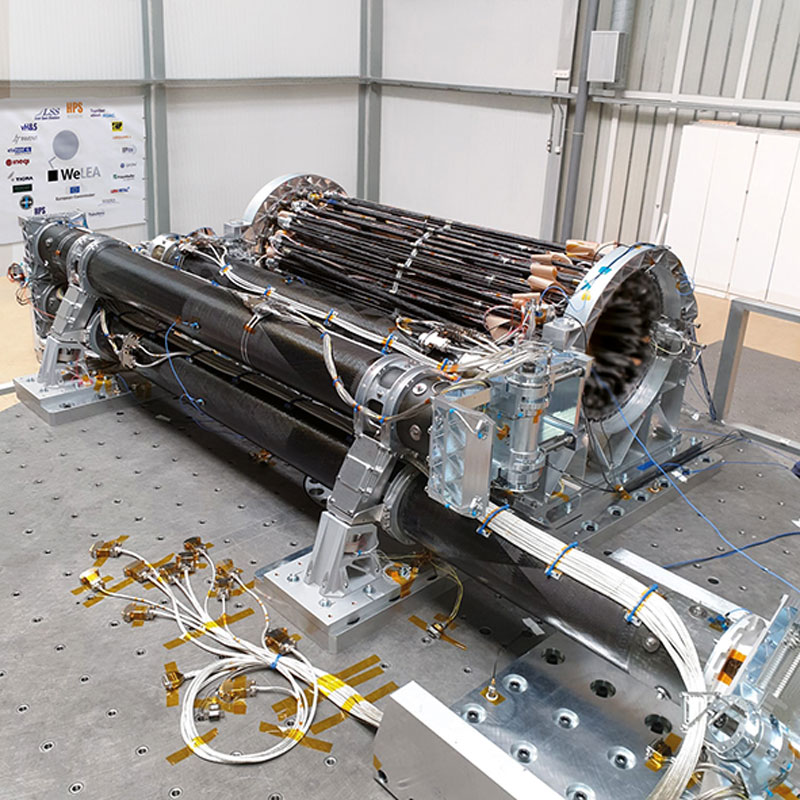
HPS announcing crucial milestone set for Europe´s own large deployable reflector subsystem (LDRS)
April 2019
Large deployable antenna reflectors are among the critical space technologies most urgently needed in Europe in order to drastically reduce the continent´s dependence on goodwill, knowhow, and supplies from the United States. Therefore, back in fall 2017 the EC decided to co-fund in the fame of its Horizon 2020-programm the 7 million € development-project LEA (Large European Antenna) of a consortium with 15 partners out of six European (D, SP, PT, SE, DK, FR) countries under the implementation leadership of HPS, Germany, among them also LSS GmbH (Germany) and RUAG Space Germany. A special cooperation between HPS and Northern Bavarian entities has already led to the development of the central component, the „European Space Mesh“; it will in future be produced in Bavaria. Now the project has taken its crucial milestone when it passed the Critical Design Review (CDR) in April 11-12, 2019, and is heading towards the final stage of its test campaign from February through August 2020. In exchange for the opportunity to gain flight heritage HPS offers the first product, LEA, for free to any customer worldwide.
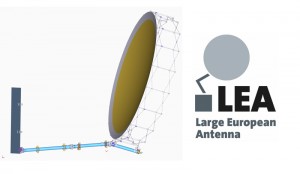
Major specs of LEA are: deployable reflector aperture at 5.1 meters with a 5.6 meter long deployable arm; a mass of just 100 kilo including reflector, arm, hold-down-and-release-mechanism, harness, thermal hardware, operating frequency: X-band. The stowed volume is as small as 2.6 x 1.2 x 0.6 meters.
This development is not only important in general, but serves also as a baseline for two potentially next Copernicus missions at the horizon with 8 and 12 meter reflector subsystems. The whole development program of LEA is based on precursors undertaken within the framework of ESA technology programs.
For more information on LEA please klick: www.welea.eu.
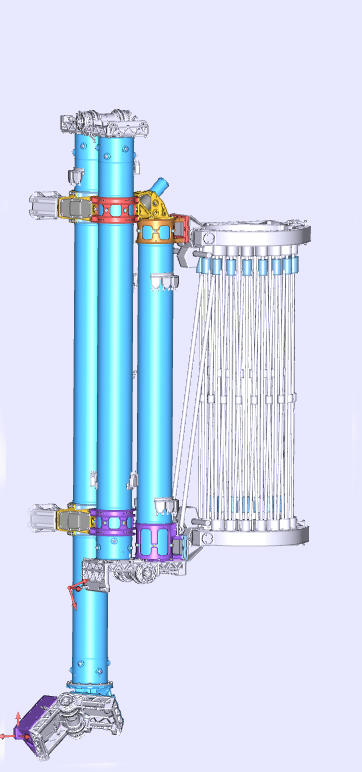
April 2019
MdB Dr. h.c. Thomas Sattelberger gratuliert HPS zur frisch gewonnenen Führungsrolle in europäischer Innovations-Offensive
Am 18. April 2019 besuchte Thomas Sattelberger (FDP), Bundestagsabgeordneter des Wahlkreises München Süd, den Raumfahrt-Mittelständler HPS. Als ausgewiesener Innovationsexperte interessierte er sich dabei vor allem für die vom deutschen Raumfahrt-Mittelstand ausgehenden Impulse für neue Technologien, mit denen Europa im Rahmen von EU und ESA seine Unabhängigkeit von Zulieferungen und Wohlwollen seitens der Konkurrenz anderer Kontinente gerade in kritischen Bereichen erkämpft.

Gerade auf diesem Gebiet hat HPS jüngst zwei bahnbrechende Erfolge zu verzeichnen: Die Entwicklung des HPS-Bremssegels ADEO zur schnellen Entsorgung ausgedienter Satelliten hat vor wenigen Monaten seinen Feuertest im All mit Bravour bestanden, und vor wenigen Tagen gewann ein von HPS geführtes Konsortium von 17 meist mittelständischen Raumfahrtunternehmen aus sechs Ländern gegen große Konkurrenz den Entwicklungsauftrag für die künftige große entfaltbare Antennentechnologie Europas mit Einsatzgebieten von Erdbeobachtung über Big Data und das Internet of Things bis hin zu militärischen und Telekommunikationsanwendungen.
HPS-CEO Dr. Ernst K. Pfeiffer nahm die Gelegenheit wahr, die Bedeutung des Ausbaus von Technologie-Programmen für die Raumfahrt-Zulieferindustrie auf nationaler und europäischer Ebene gerade auch für die Ermöglichung der Teilnahme an den steigenden internationalen Märkten und damit verbunden die Jobmaschine der Raumfahrt-KMU hervorzuheben. Die ESA Ministerratskonferenz 2019 liefert dafür die beste Gelegenheit, um sowohl die ESA-Technologieförderung über die Programme ARTES und GSTP sowie auch die deutsche Beteiligung am EU-Programm Kopernikus nachhaltig zu stärken. MdB Thomas Sattelberger bestätigte die enorme Bedeutung der Raumfahrt als Anwendung für die Menschen auf der Erde wie auch als Technologietreiber für andere Wirtschaftsbereiche. Seine Expertise hatte er selbst in langjähriger Arbeit im Bereich der bayerischen Luft- und Raumfahrttechnik gewonnen, bevor er nach seiner Position als Vorstandsmitglied bei der Deutschen Lufthansa und seiner letzten beruflichen Station als Vorstandsmitglied der Deutschen Telekom für die Freien Demokraten in den Bundestag einzog.
Second step taken towards European technological independence regarding large deployable reflectors
May 2019
HPS-consortium wins ESA´s LEOB challenge
The European consortium of 17 partners out of six European countries initiated and led by HPS GmbH has won the prestigious ESA contract for LEOB, the Large European Reflector for Earth Observation. The call had been initiated by ESA´s Earth Observation directorate in 2018.
The HPS consortium, including LSS Germany and RUAG Space Germany, won against severe competition from Italy, Spain, and the U.K.. Total budget amounts to 5 million €; taken together with contract number one on the development of a large deployable reflector out of late 2017, the budget to develop this critical technology now amounts to 12.5 million €. Future mission targets include geological changes, monitoring of vegetation, communications, Big Data, Internet of Things, and sciences.
Kick-off was on April 15th, 2019, the project will conclude with a tested Engineering Model exactly two years later in April 2021. It is the last precursor project before the development of a flight model for two future Copernicus missions: CIMR with a 7-8m reflector, operating in L- through Ka-band, rotating on top of the satellite at a speed of ten turns per minute, and ROSE-L with 12 meters of diameter, operating in L-band.
Precursing ESA-technology programs and LEA out of Horizon 2020 had laid the foundations for this great success.
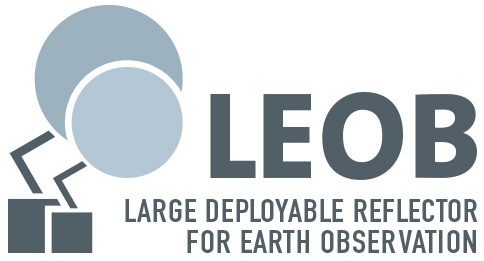
October 2019
A European Declaration of Non-dependence in Space
Dear Friends and Fans of Europe in Space,
in the name of all members of our pan-European WeLEA-consortium we proudly present a video, documenting the successful road of the development of one of the most needed critical technologies in space: the Deployable Large European Antenna (LEA).
Invented, designed, tested and manufactured by more than 15 well known space companies from 7 European countries with a total staff of more than 500 dedicated specialists, representing a truly unique team of SMEs and Midcaps, the LEA-product is now taking shape as nothing less than “A European Declaration of Non-dependence in Space”.
Thanks to the farsighted vision of both powerful institutions responsible for our continent´s future in space, the European Space Agency ESA and the European Commission EC, LEA will become an invaluable technological asset to blaze our own trail towards knowledge and understanding as indispensable prerequisites to making this world a sustainable, better place – for life in diversity, for all citizens on the globe, and for one Europe across all its internal borders.
Within the WeLEA consortium HPS Germany, as prime contractor, is responsible for the project- and technical management of the whole LEA-subsystem, the deployable arm assembly and the reflective metal mesh.
